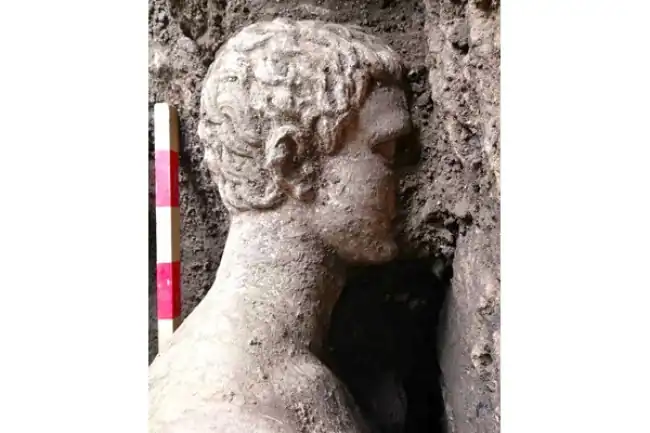
Heraclea Sintika, Bulgaria – In a remarkable archaeological breakthrough, a team led by Prof. Dr. Ludmil Vagalinski has uncovered an exceptionally well-preserved marble statue in the ancient city of Heraclea Sintika, near Petrich.
The discovery, announced by the municipality of Petrich, was found within the underground sewer system known as “Cloaca Maxima.” Efforts are currently underway to delicately excavate the statue due to its extraordinary state of preservation.
Standing over two meters tall, the statue is believed to depict Hermes, a prominent deity in the region during ancient times.
Prof. Dr. Vagalinski, in an interview with “Archaeologia Bulgarica,” expressed cautious excitement about the find, noting its significance not only as the best-preserved statue discovered in Heraclea Sintika but also in all of Bulgaria.
He suggests that the statue was likely buried by city inhabitants following a major earthquake in the 4th century AD, possibly to safeguard their religious heritage during the rise of Christianity.
Updates on the excavation progress were shared via Facebook by Archaeologia Bulgarica, revealing that the statue, crafted from a single marble block in the 2nd century AD, remains partially encased in dirt.
Archaeologists have noted its resemblance to other depictions of Hermes, placing it within a known iconographic type. Similar statues are rare globally, making this discovery particularly unique for Bulgaria.
Plans are underway to carefully extract the statue from the Cloaca Maxima and transport it to the museum in Petrich, where it will undergo necessary restoration before being displayed alongside other archaeological finds.
Prof. Vagalinski emphasized the challenges of preserving the ancient city’s structures, especially those located on private property, where permanent conservation measures are limited. He highlighted the unexpected nature of the discovery, which came to light during routine inspections of the canal’s condition.
The excavation team, which first uncovered ancient structures in the area six years ago, had placed protective barriers to secure the site. Upon closer examination, marble remnants were noticed, leading to the gradual unveiling of the statue of Hermes.
Work on fully exposing and documenting the statue will continue in the coming days, offering new insights into the religious and artistic practices of ancient Heraclea Sintika.
The significance of this find extends beyond its impressive preservation. It provides a glimpse into the cultural and religious life of the ancient city, highlighting the importance of Hermes in the local pantheon.
The careful craftsmanship of the statue, combined with its burial and preservation, speaks to the reverence the inhabitants had for their deities and the lengths they went to protect their religious symbols.
As the excavation progresses, the archaeological community eagerly awaits further details about the statue and its context within Heraclea Sintika.
The discovery has already generated significant interest among historians and archaeologists, promising to shed new light on the region’s ancient past.
With the statue set to undergo restoration, its eventual display in the Petrich museum will offer the public a rare opportunity to connect with a tangible piece of history.
This find underscores the rich archaeological heritage of Bulgaria and the potential for future discoveries in the ancient city of Heraclea Sintika.
This article was created using automation technology and was thoroughly edited and fact-checked by one of our editorial staff members
